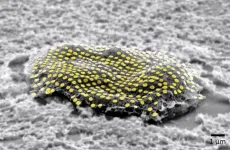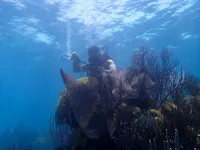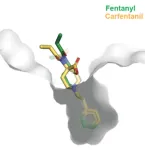(Press-News.org) Outbreaks of polycystic echicnococcosis, a life-threatening zoonotic disease, are driven by regional climate changes, according to a study led by the Barcelona Institute for Global Health (ISGlobal), an institution supported by “la Caixa” Foundation. The findings, published in PNAS, provide evidence of the impact of climate on neglected tropical diseases in the Amazon region, with implications for other zoonoses.
Polycystic echinococcosis (PE) is a neglected life-threatening zoonosis caused by an intestinal worm (Echinococcus vogeli) endemic in neotropical forests such as the Amazon. Although treatable, the disease can be fatal for about 1 in 3 infected people if not diagnosed in time. The parasite normally lives in animal reservoirs but can be transmitted to humans who handle infected animals, particularly pacas (a large rodent that is usually hunted for food).
“Polycystic echinococcosis is a good example of the many zoonotic diseases associated with the handling and consumption of wild meat,” says Xavier Rodó, ISGlobal researcher and last author of the study. “Understanding the role of climate in the emergence and spread of these zoonoses is becoming increasingly important, given the ongoing global warming scenario,” he adds.
In this study, Rodó and his team compiled two unique databases: one of PE infections in animals and humans covering the entire Amazon region (around 400 cases), and another one on hunting practices (containing almost 440,000 observations of animals hunted in 55 independent study areas in seven Amazonian countries and the French Guiana, over the last 55 years). This allowed the authors to understand the spatial distribution of PE, and to investigate how the disease is influenced by ecological, environmental and climatic factors, as well as hunting patterns. To do this, they developed two independent prediction models: one for animal infections (i.e. the sylvatic model) and one for human infections (i.e. the spillover model).
The analysis shows that stable temperatures favour the sylvatic cycle (i.e. the circulation of the parasite in animal reservoirs), while extreme climate events (such as El Niño) disrupt hunting patterns and favour parasite spillover to humans. “This means that regional climate change due to global warming may indirectly drive disease outbreaks in humans,” says Adrià San José, first author of the study. This also means that information on land use and climate projections could be useful for early warning of potential PE hotspots.
These findings have clear implications for other similar hunting-related zoonoses. They also highlight the value of comprehensive databases for understanding the role of climate in the emergence and spread of zoonotic disease outbreaks.
Reference
Adrià San-José, Pedro Mayor, Bruno Carvalho et al. Climate determines transmission hotspots of Polycystic Echinococcosis, a lifethreatening zoonotic disease, across Pan-Amazonia. PNAS. 2023.
END
Climate influences the spread of a life-threatening zoonotic disease in the Amazon
A study finds that polycystic echinococcosis, a neglected disease with a high mortality rate, is sensitive to climate, making it possible to predict potential infection hotspots
2023-08-07
ELSE PRESS RELEASES FROM THIS DATE:
Research discovers key cause of restricted blood flow to the brain in vascular dementia
2023-08-07
Groundbreaking new research has uncovered a potential route to developing the first ever drug treatments for vascular dementia, that directly target a cause of the condition. The research, funded by the British Heart Foundation and published in the journal Proceedings of the National Academy of Sciences, [1] has shed light on how high blood pressure causes changes to arteries in the brain, a process that leads to the devastating condition.
High blood pressure is a main cause of vascular dementia, a condition characterised by poor blood flow to the brain. The reduced blood supply starves brain cells of nutrients and over time they become damaged ...
Latest in body art? ‘Tattoos’ for individual cells
2023-08-07
Engineers have developed nanoscale tattoos—dots and wires that adhere to live cells—in a breakthrough that puts researchers one step closer to tracking the health of individual cells.
The new technology allows for the first time the placement of optical elements or electronics on live cells with tattoo-like arrays that stick on cells while flexing and conforming to the cells’wet and fluid outer structure.
“If you imagine where this is all going in the future, we would like to have sensors to remotely monitor and ...
Georgia State Researcher awarded $3.6 million grant to help address mental health crisis in schools
2023-08-07
ATLANTA — Catherine Perkins, a clinical professor in the College of Education & Human Development at Georgia State University, has been awarded a five-year, $3.6 million grant by the U.S. Department of Education to expand quality school-based mental health (SBMH) services for underserved populations in high-need schools.
The Expanding Quality SBMH Services for Underserved Populations with Inclusive Practices (GSU-EQUIP) grant will have a direct impact in metro Atlanta by increasing access to school-based programs and strengthening the candidate pool of mental ...
Current estimates of Lake Erie algae toxicity may miss the mark
2023-08-07
COLUMBUS, Ohio – There is more to a harmful algal bloom than the green stuff in water that meets the eye – specifically, a changing hazard level of toxins produced by the microbes that make up the scummy mess.
A new study analyzing toxins produced by Microcystis, the main type of cyanobacteria that compose the annual harmful algal bloom (HAB) in Lake Erie, suggests that the toxicity of the bloom may be overestimated in earlier warm months and underestimated later in the summer.
The research is part of a large project, led by The Ohio State University, designed to develop a more accurate harmful algal bloom toxicity forecast ...
Dogs with less complex facial markings found to be more expressive in their communication with humans
2023-08-07
WASHINGTON (August 7, 2023) – The domestication of canines and their co-evolution with humans has fostered an incredibly unique relationship with these animals. Over time, our four-legged friends have adapted well to understanding human modes of communication, both verbal and nonverbal. However, researchers at the George Washington University say humans could do more to better understand our furry companions, and a dogs’ facial markings may be one key to meeting them halfway.
In a new paper published in the journal Animals, ...
Century-old coral reveals Pacific western boundary current strengthened as climate warmed, impacting El Niño
2023-08-07
Chestnut Hill, Mass. (8/7/2023) - The Pacific Ocean’s western boundary current, which forms a critical regulator of sea surface temperature and weather patterns, has significantly strengthened as the planet warms, according to a new study published in the journal Nature Geoscience.
The study provides the first evidence that the western boundary current in the South Pacific has significantly strengthened during the 20th century in response to global warming, contributing to an intensified equatorial undercurrent, according to Boston College Assistant Professor of Earth and Environmental Sciences Xingchen (Tony) Wang, a co-author ...
For Black teens, school belonging can be a matter of life and death
2023-08-07
Academic performance has long been linked to how supported students feel at school. Now, a Rutgers study suggests this sentiment is also essential to preventing suicides.
A Rutgers researcher found that having a strong sense of school belonging – the subjective feeling of being accepted, valued, included and encouraged in the school community – could mitigate suicidal tendencies among Black adolescents.
“Having a supportive teacher or other nonparent adult can change a child’s life because they will want to go to school,” said Adrian Gale, an assistant professor at the Rutgers School of Social Work and co-author of the study ...
Human antibody that targets carfentanil, fentanyl and related opioids reverses overdose effects in preclinical study
2023-08-07
LA JOLLA, CA—An antibody in single-chain fragment variable (scFv) format that binds to the powerful opioid carfentanil was shown to reverse signs of carfentanil overdose in preclinical tests conducted by scientists at Scripps Research.
Carfentanil is a variant of the synthetic opioid fentanyl, and about 100 times as potent as its chemical cousin. Along with fentanyl and other fentanyl variants, it is commonly mixed with illegal drugs such as heroin and cocaine to enhance their euphoric effects, resulting in many fatal overdoses.
In the study, published in ACS ...
Midwest Integrated Center for Computational Materials renewed by U.S. Department of Energy
2023-08-07
The U.S. Department of Energy (DOE) has announced the renewal of the Midwest Integrated Center for Computational Materials (MICCoM) for another three years at $3 million per year. Founded in 2015, the Center is headquartered at DOE’s Argonne National Laboratory. Partnering universities include the University of Chicago, University of Notre Dame and University of California, Davis.
“The MICCoM team has been at the forefront of developing simulation methods and codes and solving cutting-edge materials science problems,” said Center director Giulia Galli. She is also a senior scientist in Argonne’s Materials Science division and professor in the ...
New blood-pressure related measure predicts health outcomes in patients with intensive care
2023-08-07
Key Takeaways
A new method derived from standard blood pressure assessments can improve monitoring of critically ill patients with circulatory shock
The method accurately predicts risk of death, length of hospital stay, and blood lactate levels (an indicator of tissue perfusion and oxygenation).
BOSTON – Critically ill patients with circulatory shock—when the heart cannot pump enough blood and oxygen to the rest of the body, often as a result of heart failure, sepsis, or hemorrhage—require close monitoring and treatment, especially to maintain adequate blood pressure to prevent injury to important organs. ...
LAST 30 PRESS RELEASES:
Tracing the quick synthesis of an industrially important catalyst
New software sheds light on cancer’s hidden genetic networks
UT Health San Antonio awarded $3 million in CPRIT grants to bolster cancer research and prevention efforts in South Texas
Third symposium spotlights global challenge of new contaminants in China’s fight against pollution
From straw to soil harmony: International team reveals how biochar supercharges carbon-smart farming
Myeloma: How AI is redrawing the map of cancer care
Manhattan E. Charurat, Ph.D., MHS invested as the Homer and Martha Gudelsky Distinguished Professor in Medicine at the University of Maryland School of Medicine
Insilico Medicine’s Pharma.AI Q4 Winter Launch Recap: Revolutionizing drug discovery with cutting-edge AI innovations, accelerating the path to pharmaceutical superintelligence
Nanoplastics have diet-dependent impacts on digestive system health
Brain neuron death occurs throughout life and increases with age, a natural human protein drug may halt neuron death in Alzheimer’s disease
SPIE and CLP announce the recipients of the 2025 Advanced Photonics Young Innovator Award
Lessons from the Caldor Fire’s Christmas Valley ‘Miracle’
Ant societies rose by trading individual protection for collective power
Research reveals how ancient viral DNA shapes early embryonic development
A molecular gatekeeper that controls protein synthesis
New ‘cloaking device’ concept to shield sensitive tech from magnetic fields
Researchers show impact of mountain building and climate change on alpine biodiversity
Study models the transition from Neanderthals to modern humans in Europe
University of Phoenix College of Doctoral Studies releases white paper on AI-driven skilling to reduce burnout and restore worker autonomy
AIs fail at the game of visual “telephone”
The levers for a sustainable food system
Potential changes in US homelessness by ending federal support for housing first programs
Vulnerability of large language models to prompt injection when providing medical advice
Researchers develop new system for high-energy-density, long-life, multi-electron transfer bromine-based flow batteries
Ending federal support for housing first programs could increase U.S. homelessness by 5% in one year, new JAMA study finds
New research uncovers molecular ‘safety switch’ shielding cancers from immune attack
Bacteria resisting viral infection can still sink carbon to ocean floor
Younger biological age may increase depression risk in older women during COVID-19
Bharat Innovates 2026 National Basecamp Showcases India’s Most Promising Deep-Tech Ventures
Here’s what determines whether your income level rises or falls
[Press-News.org] Climate influences the spread of a life-threatening zoonotic disease in the AmazonA study finds that polycystic echinococcosis, a neglected disease with a high mortality rate, is sensitive to climate, making it possible to predict potential infection hotspots



